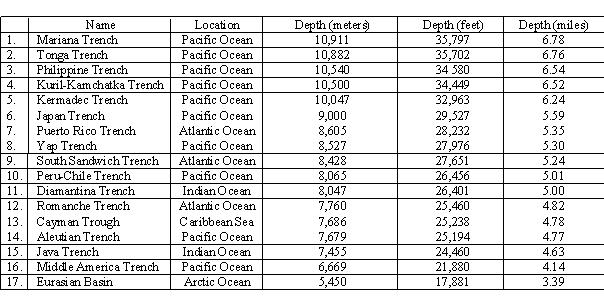It looks like you're using an Ad Blocker.
Please white-list or disable AboveTopSecret.com in your ad-blocking tool.
Thank you.
Some features of ATS will be disabled while you continue to use an ad-blocker.
share:
Not sure if anyone has mentioned any math
But the Earth gains 38,000-78,000 metric tons of matrial every year from meteorites.
That would be 78x10(12) tons every Billion years
Given that the Earth is 6x10(21) Billion Tons already. The Earth is only growing by 0.000000013 every Billion years. So unless you are suggesting a Hollow earth your theory is flawed...
But the Earth gains 38,000-78,000 metric tons of matrial every year from meteorites.
That would be 78x10(12) tons every Billion years
Given that the Earth is 6x10(21) Billion Tons already. The Earth is only growing by 0.000000013 every Billion years. So unless you are suggesting a Hollow earth your theory is flawed...
reply to post by bjarneorn
I specified changes in the diameter of the Earth. The fossil record does not reflect this. It reflects all other significant Earth changes but there is zero evidence that life ever had to cope with an increase in the Earths diameter of 40% or more
As stated before anything that floats does so because it is less dense than the liquid which it floats upon.
You present a case where a dense but thin plate slips under a much bulkier but slightly less dense plate into a liquid which is even more dense before finally melting away.
YES, This is how it happens. Fill up your sink, get a scrunched up ball of paper and a relatively flat (but denser) piece of cardboard. Put them so they’re both floating in the water then push them together. This is plate tectonics.
Again this is exactly what we see. The oceanic crust is subducted under the continental crust into the molten ductile aethenosphere where it eventually melts.
The resulting escaping gas are responsible for much of the worlds volcanic acivity such as the Pacific Ring of Fire (where the Pacific plate is subducted beneath the continents on either side of it) as well as many of the world's mountain ranges.
You are attempting to debunk established plate tectonics theory with the very facts that prove it.
Originally posted by bjarneorn
First of all, no offence. But you stated that life had not undergone any changes. For the past 100 million years. Well, actually it's undergone enormous changes ... so the arguement is self contradicting. That we can say that these changes are from life having to adapt to different environment, is a different debate entirely.
I specified changes in the diameter of the Earth. The fossil record does not reflect this. It reflects all other significant Earth changes but there is zero evidence that life ever had to cope with an increase in the Earths diameter of 40% or more
Second, I urge you to find two different materials of different density and try to push the lighter density one, into the creater density one. It's not merely a "lighter" material into a heavier one, or something floating on water. Because oil floats, not because of it's composition, but because of the shape of the oil molecule. It "can" sink ... the same applies to Iron ... it'll sink as a rock, even if a ship made of steel will float.
As stated before anything that floats does so because it is less dense than the liquid which it floats upon.
You present a case where a dense but thin plate slips under a much bulkier but slightly less dense plate into a liquid which is even more dense before finally melting away.
YES, This is how it happens. Fill up your sink, get a scrunched up ball of paper and a relatively flat (but denser) piece of cardboard. Put them so they’re both floating in the water then push them together. This is plate tectonics.
What we're talking about, is "impossible". It's like trying to have rock, sink into steel. Yes, it will sink into liquid steel wich is much hotter than rock. Because it will "melt". And the effect you will see, is eruption of gases. The mantle is pressurised and magma is magnetic. It's electromagnetism is evident, in volcanic eruptions. However, in case of the mantle. It is generally objected to that it is molten ... it is considered to be preassurised rock, slightly liquid, highly resistive.
Again this is exactly what we see. The oceanic crust is subducted under the continental crust into the molten ductile aethenosphere where it eventually melts.
The resulting escaping gas are responsible for much of the worlds volcanic acivity such as the Pacific Ring of Fire (where the Pacific plate is subducted beneath the continents on either side of it) as well as many of the world's mountain ranges.
You are attempting to debunk established plate tectonics theory with the very facts that prove it.
edit on 12/9/2012 by 1littlewolf because: (no reason given)
My question about the expanding Earth theory is, and maybe its been answered in a previous post, how did the oceans form? In the youtube video they
showed all of the continents together with a few seas, and all of a sudden those seas turned into oceans? How?
edit on 12-9-2012 by
majesticgent because: (no reason given)
reply to post by bjarneorn
Was that sarcasm? Imagine the image I pointed out before, laid completely flat. What you would have is one large landmass...Pangaea. Which OP claims to have debunked. Yet is clearly visible in his OP.
The thread title, and the premise, might be just a tad inaccurate.
Was that sarcasm? Imagine the image I pointed out before, laid completely flat. What you would have is one large landmass...Pangaea. Which OP claims to have debunked. Yet is clearly visible in his OP.
The thread title, and the premise, might be just a tad inaccurate.
reply to post by majesticgent
OP is proposing that the surface of the earth expanded along with the entirety of its mass, which would mean more room for water and such. Considering the ice ages, it's not too unlikely that all the ice turned little lakes into vast oceans. What's questionable is how the Earth could have been so small and NOT have one large land mass called "Pangaea".
OP is proposing that the surface of the earth expanded along with the entirety of its mass, which would mean more room for water and such. Considering the ice ages, it's not too unlikely that all the ice turned little lakes into vast oceans. What's questionable is how the Earth could have been so small and NOT have one large land mass called "Pangaea".
Originally posted by bjarneorn
Originally posted by lonegurkha
No I'm not saying that at all. These are both theories, and therefore automatically suspect. There is some fossil evidence for Pangaea.I have seen little evidence for the expanding earth, at least nothing I would describe as convincing.
Which is nonsense ... there are no fossil evidence for Pangea. There are fossil evidence, for the continents being connected ... that does not mean, it's Pangea. And NASA has already stated, that the earth is growing the thickness of a hair, each year. Do you have any idea, of how much matter is being accredited to the earth every year, if it is growing by the thickness of a hair?
Basically, it's a statement that in the beginning, the earth was smaller than Venus and has grown to this size. So, it's a proof of the earth growing ...
The only disagreement is, how much ... have you ever heard anyone, who is a scientist, say that an error the size of 0.0001 is insignificant? That's not very scientific is it ... that's a political statement, saying an error in measurement is insignificant.
In any science, it's enormously significant.
Here's a google link to allow you to perhaps learn something about what you are talking about. You say there is no evidence for Pangaea, well here's a link to a google search that has over 100000 hits.
Pangaea evidence
I, of coarse realize that facts have no bearing on your beliefs. But I post the link so perhaps learning can take place. There is even a utube video for the reading challenged.
As I said in my other posts these are just theories and are therefore suspect from the start. Neither cover all the bases so to speak, and neither are conclusively proven.
Cherrypicking my words and taking what I said out of context is what politicians do. I suggest you chose a link from the google search and learn about some scientific evidence.
reply to post by Shadow Herder
I'm not seeing what you are thinking is wrong with the theory...
What is it again? maybe you can use simple thoughts and small words for people like me, who can't see what the bone of contention is with the presentation in the OP. It seems you are upset that Siberia and Alaska have hooked up, but don't have the same reservations about the other land bridges that have built up in the interim, such as the one tht now connects South and North America, which is only around 3 million years old, and has mucked up ocean currents to the point of cooling the planet below it's proper temperature. Why is that one not a problem?
I'm not seeing what you are thinking is wrong with the theory...
What is it again? maybe you can use simple thoughts and small words for people like me, who can't see what the bone of contention is with the presentation in the OP. It seems you are upset that Siberia and Alaska have hooked up, but don't have the same reservations about the other land bridges that have built up in the interim, such as the one tht now connects South and North America, which is only around 3 million years old, and has mucked up ocean currents to the point of cooling the planet below it's proper temperature. Why is that one not a problem?
reply to post by nenothtu
Refer to my previous posts. I grow weary of typing the same argument for those unwilling to check all the thread responses.
Refer to my previous posts. I grow weary of typing the same argument for those unwilling to check all the thread responses.
I thought most of the theories were based upon the soil samples, fossil records, common type of species alive/dead from the regions around the world
from the top 1 to 2 km surface from the previously joined continents/countries to prove the pangea. No?
reply to post by hp1229
I suspect the whole reason Pangaea is being questioned now is because I used it in an argument on one of the religion threads. I've rarely, if ever, seen it mentioned in anything other than passing before that. I used it recently in an argument, and suddenly it crops up.
That's the only reason we're discussing it now, methinks. I could be wrong though.
I suspect the whole reason Pangaea is being questioned now is because I used it in an argument on one of the religion threads. I've rarely, if ever, seen it mentioned in anything other than passing before that. I used it recently in an argument, and suddenly it crops up.
That's the only reason we're discussing it now, methinks. I could be wrong though.
First post for me everyone!
I just wanted to bring up a point I didn't see in anyone's previous posts regarding this topic. The theory itself makes sense. I can see both sides of the argument, both for Expanding Earth and Pangaea. If the same Expanding Earth theory was true for not just the Earth, but for all bodies rotating in space, ie, other planets, then that *could* explain why Mars is now without an atmosphere. Mars expanded so much and it's atmosphere was stretched so thin, that eventually it dissipated into space. The planet grows to such an extent, the once thick and thriving atmosphere is reduced to nothing or next to nothing. Of course, the atmosphere wouldn't disappear on all planets, but it seems highly likely.
Just a thought.
I just wanted to bring up a point I didn't see in anyone's previous posts regarding this topic. The theory itself makes sense. I can see both sides of the argument, both for Expanding Earth and Pangaea. If the same Expanding Earth theory was true for not just the Earth, but for all bodies rotating in space, ie, other planets, then that *could* explain why Mars is now without an atmosphere. Mars expanded so much and it's atmosphere was stretched so thin, that eventually it dissipated into space. The planet grows to such an extent, the once thick and thriving atmosphere is reduced to nothing or next to nothing. Of course, the atmosphere wouldn't disappear on all planets, but it seems highly likely.
Just a thought.
Maybe the water was always here. Maybe the earth was compact and the surface was covered in water like a giant ball of rock or w/e with a magma or
plasma core. Then at some point as the earth expanded the solid surface area grew larger. Each time an expansion took place magma would fill in and
harden. Is it possible the water though still here now has more space to occupy therefore landmasses rise above. This I think would also answer the
question as to why the oceans are so deep, it's because the crust is thinner due to the fact that it's just a layer of earth filling in the gaps the
expansion left. I dunno I'm not a scientist but if the earth is expanding that makes sense.
Originally posted by ZakOlongapo
reply to post by Atzil321
so how U explain that america is every year few cm more fare from europe? and asia even more cm fare from america in pacific in year time?
dont ask for proof, do education Your self...edit on 12-9-2012 by ZakOlongapo because: (no reason given)edit on 12-9-2012 by ZakOlongapo because: (no reason given)
When you make a statement.
You must provide proof or links to back-up your statement.
reply to post by dolfan1678
Studies suggest that Mars was once very much like Earth, but something destroyed its atmosphere...perhaps deliberately. I'm thinking that the relevant history was wiped out with one shift or another in cultures...or scattered enough to cast doubt on the validity.
Studies suggest that Mars was once very much like Earth, but something destroyed its atmosphere...perhaps deliberately. I'm thinking that the relevant history was wiped out with one shift or another in cultures...or scattered enough to cast doubt on the validity.
reply to post by AfterInfinity
I absolutely agree. Mars, at some point in time was very much Earth-like. The real reasons for it's demise, whether natural or intelligently made, may never be known. Hopefully, someday we will know either through disclosure or discovery.
I absolutely agree. Mars, at some point in time was very much Earth-like. The real reasons for it's demise, whether natural or intelligently made, may never be known. Hopefully, someday we will know either through disclosure or discovery.
Pangea may still hold some weight and heres why. One of the Earth's oldest names is Ti.Amat. The termcomes form Sumeria and means "Watery Monster".
One of Nibiru's (yes that Nibiru/Planet x etc...) moons smashed into this planet eons ago. The the lower half of the impact created the Hammered Out
Bracelet (asteroid belt). The upper half became Gaia. The term Gaia means "cleaved planet". We all know that to cleave something is to take a chunk
out of it. This Is the Part in Gensis when the "lights fell upon the waters and caused all of the water to be drawn to one place". This very
discription means that only one piece of land was visible at that time.
Originally posted by Oannes
Pangea may still hold some weight and heres why. One of the Earth's oldest names is Ti.Amat. The termcomes form Sumeria and means "Watery Monster". One of Nibiru's (yes that Nibiru/Planet x etc...) moons smashed into this planet eons ago. The the lower half of the impact created the Hammered Out Bracelet (asteroid belt). The upper half became Gaia. The term Gaia means "cleaved planet". We all know that to cleave something is to take a chunk out of it. This Is the Part in Gensis when the "lights fell upon the waters and caused all of the water to be drawn to one place". This very discription means that only one piece of land was visible at that time.
I tend to believe along these lines.
Doesn't that also have something to do with Earth's wobbly rotation and off center axis?
Looking for a New Model?
If the theory of expanding earth worked, the Pacific would not be shrinking as the Atlantic expands.
www.mahalo.com...
www.enchantedlearning.com...
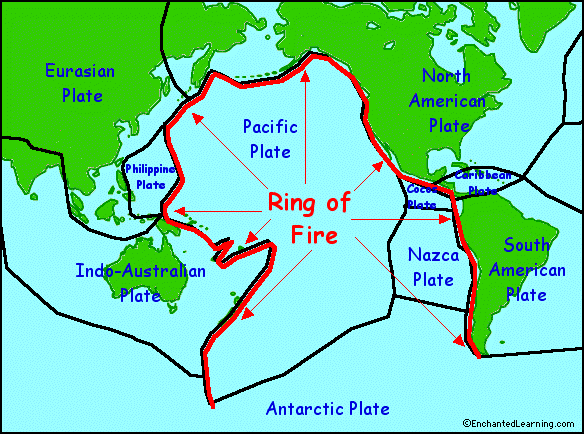
www.quora.com...
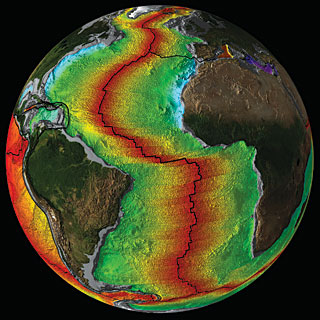
www.scientificamerican.com...
www.ouramazingplanet.com...
geography.about.com...
The following is a list of the deepest parts of the Earth's oceans and seas.
All depths are measured from sea level.
www.shorstmeyer.com...
This shows that the Pacific is deeper overall than any other ocean. My hypothesis is that the Pacific is a wound in the side of the planet which the planet is trying to heal. The cause of this wound would not only explain how plate tectonics began but also where the asteroid belt between Mars and Jupiter came from. These drawings illustrate my hypothesis quite nicely. Some of you will recognize these drawings. I am not supporting everything Zecharia Sitchin wrote or said nor am I supporting or denying the 2012 planet X conspiracy.
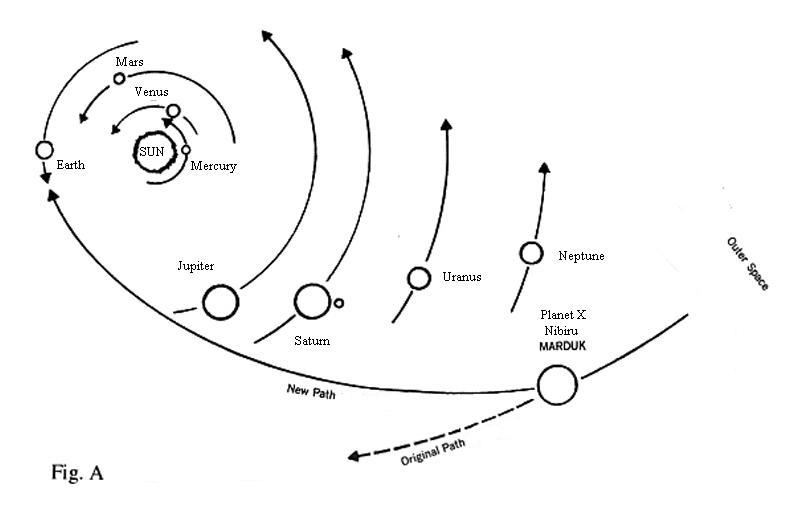
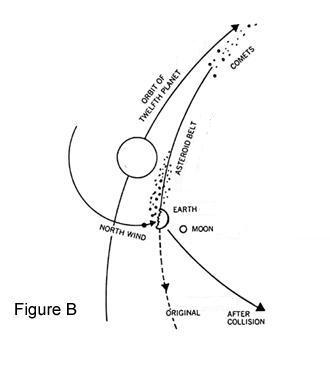
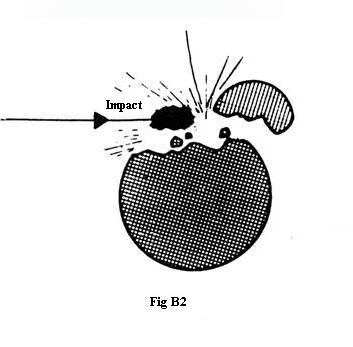
If the theory of expanding earth worked, the Pacific would not be shrinking as the Atlantic expands.
Due to the constant shifting of the earth's many plates, the Pacific Ocean is shrinking, while the Atlantic is expanding.
www.mahalo.com...
When two continental plates collide (at a convergent plate boundary like the Ring of Fire), some crust is destroyed in the impact and the plates become smaller. The results differ, depending upon what types of plates are involved.
Oceanic Plate and Continental Plate - When a thin, dense oceanic plate collides with a relatively light, thick
continental plate, the oceanic plate is forced under the continental plate; this phenomenon is called subduction.
www.enchantedlearning.com...

The Pacific Ocean is the only ocean to be completely bordered by subduction zones, where the earth's crust converges and essentially moves back into the planet.
www.quora.com...

Mid-Atlantic Ridge, a 10,000-kilometer-long string of volcanoes at the bottom of the Atlantic Ocean, is the longest mountain range in the world.
www.scientificamerican.com...
"Our study provides an independent confirmation that the solid Earth is not getting larger at present, within current measurement uncertainties," said Xiaoping Wu of NASA's Jet Propulsion Laboratory.
www.ouramazingplanet.com...
The average depth of the Atlantic Ocean is 12,880 feet (3,926 m) and the deepest point is the Puerto Rico Trench at -28,231 feet (-8,605 m).
The average depth of the Indian Ocean is 13,002 feet (3,963 m) and the Java Trench is its deepest point at -23,812 feet (-7,258 m).
The average depth of the Pacific Ocean is 13,215 feet (4,028 m) but its deepest point is the Challenger Deep within the Mariana Trench near Japan. This area is also the deepest point in the world at -35,840 feet (-10,924 m).
geography.about.com...
The following is a list of the deepest parts of the Earth's oceans and seas.
All depths are measured from sea level.
www.shorstmeyer.com...
This shows that the Pacific is deeper overall than any other ocean. My hypothesis is that the Pacific is a wound in the side of the planet which the planet is trying to heal. The cause of this wound would not only explain how plate tectonics began but also where the asteroid belt between Mars and Jupiter came from. These drawings illustrate my hypothesis quite nicely. Some of you will recognize these drawings. I am not supporting everything Zecharia Sitchin wrote or said nor am I supporting or denying the 2012 planet X conspiracy.



reply to post by dolfan1678
The Emerald Tablets, otherwise known as the Tablets of Thoth, as well as various obscure writings from ancient history, claim that humans on Mars took the exact route we did as a result of the Luciferian Experiment, or separating themselves from the creative unity of the universe. As a result, they became a warring species (exactly as we have) and for whatever reason, they blew up the atmosphere.
They used the Merkahbah to transport themselves to this world, changing the course of history from that point. Steering back toward the original topic, expansion of Mars is only one possible theory, and I don't really see much evidence to support it. It makes much more sense to think we destroyed it...after all, look at what we're doing to Earth.
The Emerald Tablets, otherwise known as the Tablets of Thoth, as well as various obscure writings from ancient history, claim that humans on Mars took the exact route we did as a result of the Luciferian Experiment, or separating themselves from the creative unity of the universe. As a result, they became a warring species (exactly as we have) and for whatever reason, they blew up the atmosphere.
They used the Merkahbah to transport themselves to this world, changing the course of history from that point. Steering back toward the original topic, expansion of Mars is only one possible theory, and I don't really see much evidence to support it. It makes much more sense to think we destroyed it...after all, look at what we're doing to Earth.
reply to post by Oannes
I love it when science throws a new perspective on scriptures...it's like hearing an old story told using different characters.
I love it when science throws a new perspective on scriptures...it's like hearing an old story told using different characters.
edit on
12-9-2012 by AfterInfinity because: (no reason given)
new topics
-
Bizarre Labour Party Tic Toc Video Becomes Even More Embarrassing
Regional Politics: 1 hours ago -
Potter to WHU
World Sports: 7 hours ago -
Dr. Demento
Music: 9 hours ago -
The elephant in the room (wearing a hoodie)
US Political Madness: 9 hours ago
top topics
-
The elephant in the room (wearing a hoodie)
US Political Madness: 9 hours ago, 14 flags -
To become president, Zelensky had to learn Ukrainian
Political Conspiracies: 15 hours ago, 9 flags -
Dr. Demento
Music: 9 hours ago, 6 flags -
Bizarre Labour Party Tic Toc Video Becomes Even More Embarrassing
Regional Politics: 1 hours ago, 3 flags -
Potter to WHU
World Sports: 7 hours ago, 2 flags
active topics
-
Los Angeles brush fires latest: 2 blazes threaten structures, prompt evacuations
Mainstream News • 219 • : WeMustCare -
Bizarre Labour Party Tic Toc Video Becomes Even More Embarrassing
Regional Politics • 7 • : Athetos -
To become president, Zelensky had to learn Ukrainian
Political Conspiracies • 31 • : FlyersFan -
S.C. Jack Smith's Final Report Says Trump Leads a Major Conspiratorial Criminal Organization!.
Political Conspiracies • 45 • : WeMustCare -
President Carter has passed
Mainstream News • 54 • : WeMustCare -
The Truth about Migrant Crime in Britain.
Social Issues and Civil Unrest • 43 • : angelchemuel -
The Fight for Election Integrity Continues -- Audits, Criminal Investigations, Legislative Reform
2024 Elections • 4374 • : IndieA -
What Comes After January 20th
Mainstream News • 37 • : xuenchen -
Potter to WHU
World Sports • 3 • : gortex -
Post A Funny (T&C Friendly) Pic Part IV: The LOL awakens!
General Chit Chat • 8007 • : underpass61

